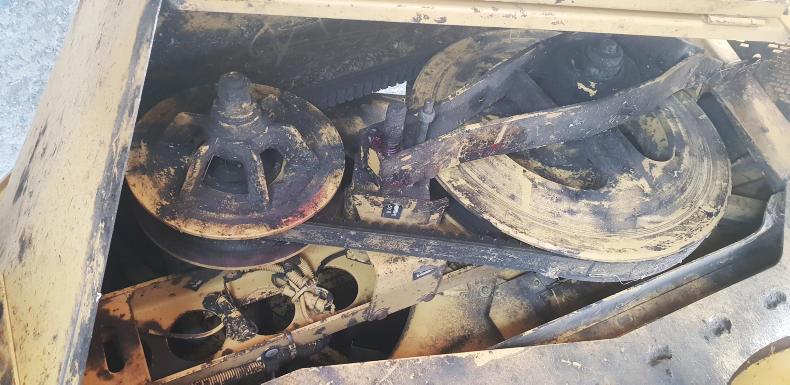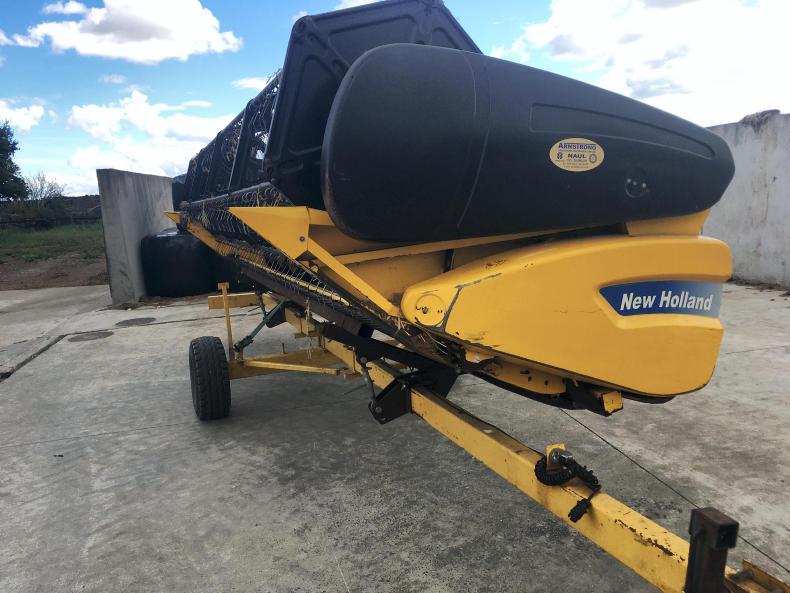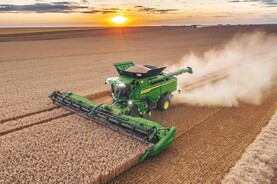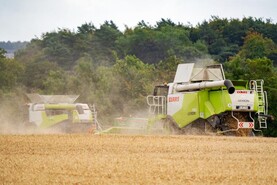The combine harvester typically spends around 10 months of the year housed in a shed, before being pushed to its limits by the ever-changing weather conditions.
Combine harvesters are expected to perform to their potential when the time comes and as a result they must receive a thorough check-over and servicing to minimise the risk of any costly downtime due to niggly issues or breakdowns.
As all machine operators are well aware, it is impossible to eliminate all risks no matter how well you service a combine, particularly with older machines. However, a thorough run-through ensures minimal risk of downtime.
The workings
The modern walker-type combine harvester has evolved from the vintage stationary threshing sets. With the addition of a header, an engine, a transmission and a cab you have a combine harvester.
It goes without saying that the engineering is certainly not as simple as that, but you get the idea. Different manufacturers have different features and variations of the core design to make their own machines unique.
However, all these machines are still very comparable, featuring a header with a reel and knife auger, which feeds a neck chain. The neck chain then in turn feeds a threshing drum. The grain and straw go their separate ways, with the straw climbing the walkers until ejected out the rear of the combine.
The grain undergoes cleaning and separation in the shaker shoe. The heavier grains fall to the bottom where they are transferred to the tank by an elevator with rubber paddles. The light grains and chaff are blown out the back by a fan. Once the tank is full, the grain is transferred to a trailer by an unloading auger.
Regardless of the brand, there is a lot going on inside the combine. There are chains and sprockets using both precision and plain chain, belts and pulleys using single, double-side and multiple-banded belts, bearings including plain, self-aligning, thrust, spherical roller, timber and so on.
Overload protection mechanisms include friction, serrated and engagement clutches and hydraulic systems. Sophisticated hydraulic, hydrostatic drives, variable speed belt and pulley drives, electric and electronic systems are all part of modern-day combine harvesters. And that’s not including the engine.
Weather
It is essential to take into account that warmer temperatures can pose some increased hazards for combines. Engines will run at higher temperatures, with the risk of overheating. The risk of fire hazard will greatly increase due to the build-up of dust and debris around the hardest-working parts.
Running
Running a combine harvester engine and drives, with the header in place, may possibly show up any bearings that are beginning to fail or are getting hot quickly. Operators should listen out for anything that doesn’t sound quite right and carefully investigate while the machine is at a standstill.
Belts should be tensioned before being inspected for any wear and tear and replaced if deemed gone beyond their lifespan. The feeder house floor should be inspected for any wear. Likewise, the concave should be checked for excess wear. Where possible, all bearings should be inspected for signs of fatigue.
Towards the latter end of last year’s harvest or even during this year’s winter crop harvest, tyres may have picked up cuts, tears or bulges. Tyres should be closely inspected for any damage to detect any potential problems at an early stage.

Daily checks
Operators should aim to clean down the machine on a daily basis. All top combine operators have established a set routine either in the morning or later in the evening for carrying out daily maintenance and checks.
A compressor should be used to blow off any grain, dirt or straw which has built up on the combine. It is advisable to start firstly with the grain tank and then work from the front to the rear of the machine. The sieves should occasionally be taken out to be cleaned and they should be inspected for damage or if there are any foreign objects stuck in them.
While cleaning down the machine on a daily basis, it provides the operator a great opportunity to spot any potential issues or areas where some TLC may be required. This can include damaged belts, worn auger-flights, or leaking hydraulic hoses. Replacing these items now may save hours of downtime when the machine needs to be in the field harvesting.
Daily maintenance of a combine includes greasing all nipples, ensuring the chains are adequately tight and adjusting tensioners if required in addition to inspecting the air filters for cleanliness. It is advisable that engine and hydraulic oil levels be checked daily while radiators should have sufficient water, especially in hot weather.
Header
The header is the first part of the machine in contact with the crop and comprises a lot of moving parts. As a result, it should be inspected regularly for damage to knives, skids or fingers. The wobble box should be greased and oiled according to the manufacturer’s recommendations.
The stone trap is located to the rear of the header and it is advisable that it is emptied on a daily basis. Stone traps are generally easy to access and debris typically will build up in the trap over the course of a long working day.

The header should be inspected regularly for damage to knives, skids or fingers.
Workshop
As farmers/contractors can never eliminate all risks of mechanical breakdown it is advisable that a selection of parts should be safely stored within the workshop. Some of these parts include a full set of belts, a selection of pulleys, a selection of chains, an assorted selection of bearings and a spare knife.
It goes without saying that a supply of engine/hydraulic oil and coolant are essentials in any workshop. Other smaller but essential spares should be kept including nuts, bolts and a broad selection of tools to get the job done.
The combine harvester typically spends around 10 months of the year housed in a shed, before being pushed to its limits by the ever-changing weather conditions.
Combine harvesters are expected to perform to their potential when the time comes and as a result they must receive a thorough check-over and servicing to minimise the risk of any costly downtime due to niggly issues or breakdowns.
As all machine operators are well aware, it is impossible to eliminate all risks no matter how well you service a combine, particularly with older machines. However, a thorough run-through ensures minimal risk of downtime.
The workings
The modern walker-type combine harvester has evolved from the vintage stationary threshing sets. With the addition of a header, an engine, a transmission and a cab you have a combine harvester.
It goes without saying that the engineering is certainly not as simple as that, but you get the idea. Different manufacturers have different features and variations of the core design to make their own machines unique.
However, all these machines are still very comparable, featuring a header with a reel and knife auger, which feeds a neck chain. The neck chain then in turn feeds a threshing drum. The grain and straw go their separate ways, with the straw climbing the walkers until ejected out the rear of the combine.
The grain undergoes cleaning and separation in the shaker shoe. The heavier grains fall to the bottom where they are transferred to the tank by an elevator with rubber paddles. The light grains and chaff are blown out the back by a fan. Once the tank is full, the grain is transferred to a trailer by an unloading auger.
Regardless of the brand, there is a lot going on inside the combine. There are chains and sprockets using both precision and plain chain, belts and pulleys using single, double-side and multiple-banded belts, bearings including plain, self-aligning, thrust, spherical roller, timber and so on.
Overload protection mechanisms include friction, serrated and engagement clutches and hydraulic systems. Sophisticated hydraulic, hydrostatic drives, variable speed belt and pulley drives, electric and electronic systems are all part of modern-day combine harvesters. And that’s not including the engine.
Weather
It is essential to take into account that warmer temperatures can pose some increased hazards for combines. Engines will run at higher temperatures, with the risk of overheating. The risk of fire hazard will greatly increase due to the build-up of dust and debris around the hardest-working parts.
Running
Running a combine harvester engine and drives, with the header in place, may possibly show up any bearings that are beginning to fail or are getting hot quickly. Operators should listen out for anything that doesn’t sound quite right and carefully investigate while the machine is at a standstill.
Belts should be tensioned before being inspected for any wear and tear and replaced if deemed gone beyond their lifespan. The feeder house floor should be inspected for any wear. Likewise, the concave should be checked for excess wear. Where possible, all bearings should be inspected for signs of fatigue.
Towards the latter end of last year’s harvest or even during this year’s winter crop harvest, tyres may have picked up cuts, tears or bulges. Tyres should be closely inspected for any damage to detect any potential problems at an early stage.

Daily checks
Operators should aim to clean down the machine on a daily basis. All top combine operators have established a set routine either in the morning or later in the evening for carrying out daily maintenance and checks.
A compressor should be used to blow off any grain, dirt or straw which has built up on the combine. It is advisable to start firstly with the grain tank and then work from the front to the rear of the machine. The sieves should occasionally be taken out to be cleaned and they should be inspected for damage or if there are any foreign objects stuck in them.
While cleaning down the machine on a daily basis, it provides the operator a great opportunity to spot any potential issues or areas where some TLC may be required. This can include damaged belts, worn auger-flights, or leaking hydraulic hoses. Replacing these items now may save hours of downtime when the machine needs to be in the field harvesting.
Daily maintenance of a combine includes greasing all nipples, ensuring the chains are adequately tight and adjusting tensioners if required in addition to inspecting the air filters for cleanliness. It is advisable that engine and hydraulic oil levels be checked daily while radiators should have sufficient water, especially in hot weather.
Header
The header is the first part of the machine in contact with the crop and comprises a lot of moving parts. As a result, it should be inspected regularly for damage to knives, skids or fingers. The wobble box should be greased and oiled according to the manufacturer’s recommendations.
The stone trap is located to the rear of the header and it is advisable that it is emptied on a daily basis. Stone traps are generally easy to access and debris typically will build up in the trap over the course of a long working day.

The header should be inspected regularly for damage to knives, skids or fingers.
Workshop
As farmers/contractors can never eliminate all risks of mechanical breakdown it is advisable that a selection of parts should be safely stored within the workshop. Some of these parts include a full set of belts, a selection of pulleys, a selection of chains, an assorted selection of bearings and a spare knife.
It goes without saying that a supply of engine/hydraulic oil and coolant are essentials in any workshop. Other smaller but essential spares should be kept including nuts, bolts and a broad selection of tools to get the job done.








 This is a subscriber-only article
This is a subscriber-only article










SHARING OPTIONS: